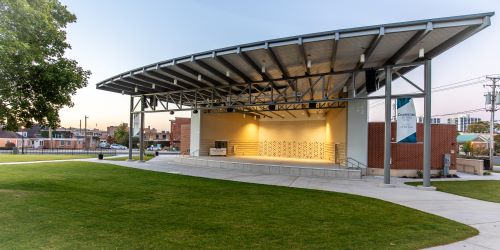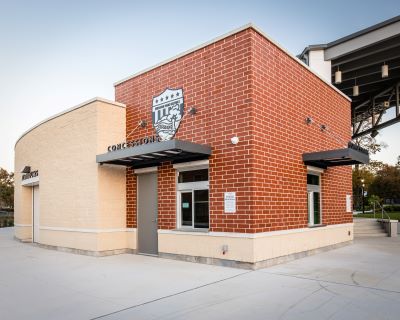Wheaton, Ill., may be a suburb of Chicago, but this city of more than 50,000 residents has its own distinct character. Ranked the “#1 Place to Live in Illinois” by Money Magazine, the vibrant downtown includes a variety of retail shops, salons, day spas and more than 130 restaurants. The adjacent Wheaton Memorial Park recently saw vast improvements, along with the debut of the park’s long-anticipated new amphitheater.
As a result of its longstanding alliance with the Wheaton Park District, Itasca-based Williams Architects, a national

leader in park and recreation design, was chosen to oversee the configuration of the new performance venue along with other improvements. Key decision-makers had quickly determined that a new, more expansive, modernized structure was needed to replace a weathered bandstand.
Andy Dogan, principal and project executive, and Steve Mihelich, principal and director of design, headed up efforts for conceptualizing the new venue. The multifaceted amphitheater required all hands on deck for the Williams group with structural, aesthetic and sound quality aspects to be integrated into facility plans.
Echelon Masonry’s Cordova Stone was selected to complete the inner walls of the 2,600-square-foot stage. The high-density, prefinished architectural stone cladding mimics the look of natural stone by incorporating all-natural aggregates and recycled content.
“The amphitheater backs up to the southwest corner of the village district, so being on the edge of that business center and within the heritage of the park, we found the look of Cordova to be a very appropriate complement to the materiality of the of those surrounding buildings with the design of a curved stone wall to complement the public plaza at this location,” Mihelich said.
 In addition, the architectural units were customized to achieve specific acoustical results. “The standard shapes and textures available in Cordova Stone really helped enable us to achieve our acoustical goals,” Dogan said, adding that the product’s modularity “worked very well with the sound quality profile as far as articulating each of the back and side walls. We were able to create different patterns to achieve the right blend of absorption and reflection.
In addition, the architectural units were customized to achieve specific acoustical results. “The standard shapes and textures available in Cordova Stone really helped enable us to achieve our acoustical goals,” Dogan said, adding that the product’s modularity “worked very well with the sound quality profile as far as articulating each of the back and side walls. We were able to create different patterns to achieve the right blend of absorption and reflection.
“Brad Moser, our project architect, worked on the detailing of materials to match and coordinate masonry products to the specific acoustic characteristics we were trying to achieve,” he added.
The custom angles of the units were precut at the manufacturing plant, a huge time saver when it came time for installation. The masonry work was completed by Piazza and Mannerino Masonry, a Homer Glen, Ill.-based firm with a respected reputation in large commercial projects. Tony Mannerino commented, “It was such an intricate project, but thankfully we had basically no cutting to do on this job.”
“The venue is extremely successful,” Dogan said, “and has become very much in-demand in the musical community. Performers love playing here. Not only does the sound project out to the audience, but it is equally important for a large ensemble of 80 or 90 musicians be able to hear themselves, which is much harder to do in this type of open-air venue. The positive feedback has been incredible.”


